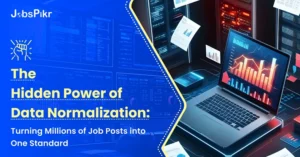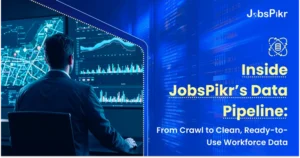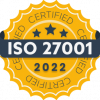The need for a data-driven approach has never been more critical during the current landscape of HR function. Workforce analytics plays a pivotal role in strategic talent management, providing HR professionals with the insights needed to align talent strategies with organizational goals and achieve better outcomes. This article delves into the significance of HR workforce analytics for data driven strategy, explores how workforce analytics software can be leveraged, and highlights the benefits of adopting a data-driven approach in HR.
Understanding Workforce Analytics
Workforce analytics for HR strategy refers to the use of data analysis techniques to examine and interpret employee-related data. This data encompasses various aspects, including recruitment, performance, employee engagement, turnover rates, and more. By analyzing this data, HR professionals can identify patterns, predict trends, and make informed decisions that enhance the overall effectiveness of talent management strategies.
Enhancing HR Strategy Using Workforce Analytics Software
Workforce analytics plays a crucial role in this process by providing HR professionals with the tools and insights needed to make informed, data-driven decisions. This approach not only improves overall efficiency but also ensures that the right talent is in place to drive the company forward.

Image Source: Visier
1. Data-Driven Decision Making
Incorporating HR workforce analytics enables data-driven decision making. By analyzing historical and real-time data, HR professionals can gain insights into employee behaviors, performance metrics, and potential areas for improvement. This data-driven approach minimizes guesswork and ensures that decisions are based on concrete evidence.
2. Identifying Talent Gaps and Needs
Workforce analytics helps identify talent gaps and future needs within the organization. By analyzing data on current employees’ skills and competencies, HR can proactively address skill shortages and plan for future talent requirements. This foresight allows for better workforce planning and ensures that the organization has the right talent in place to achieve its goals.
3. Enhancing Employee Engagement and Retention
Employee engagement and retention are critical factors in an organization’s success. Workforce analytics can provide insights into factors that influence employee satisfaction and identify potential reasons for turnover. Armed with this information, HR can implement targeted interventions to enhance employee engagement, improve retention rates, and reduce the costs associated with high turnover.
4. Optimizing Recruitment Strategies
Recruitment is a fundamental aspect of HR strategy, and workforce analytics can significantly enhance the recruitment process. By analyzing data on past hiring successes and failures, HR professionals can refine their recruitment strategies, identify the most effective sourcing channels, and improve the quality of hires. This optimization leads to more efficient hiring processes and better alignment between new hires and organizational needs.
5. Aligning Talent with Organizational Goals
Workforce analytics allows HR to align talent management strategies with broader organizational goals. By understanding the skills and competencies required to achieve strategic objectives, HR can ensure that the right talent is in place to drive the organization forward. This alignment fosters a cohesive and high-performing workforce that is better equipped to meet business challenges.
Leveraging Workforce Analytics Software
The effectiveness of HR workforce analytics for strategy building is greatly enhanced by the use of workforce analytics software. At the heart of this transformation lies the ability to leverage data effectively. While the concept of workforce analytics is powerful, its true strategic impact is unlocked only through sophisticated workforce analytics software. These platforms are not mere data repositories; they are dynamic engines that empower HR professionals to collect, synthesize, analyze, visualize, and act upon employee data with unprecedented speed, accuracy, and insight.
The features of these tools fundamentally reshape how HR contributes to organizational strategy, moving from intuition-based recommendations to data-driven imperatives. Let’s delve deeper into the capabilities that make this possible and explore their profound strategic implications.
1. Data Integration
The foundational strength of workforce analytics software lies in its ability to integrate data from a multitude of often disparate sources. Modern HR ecosystems are complex, generating valuable data points across numerous systems:
- Core HRIS: Employee demographics, tenure, compensation history, job history, reporting structures.
- Payroll Systems: Detailed compensation, bonuses, tax data, deductions.
- Performance Management Tools: Goal tracking, performance ratings, competency assessments, 360-degree feedback.
- Recruitment/ATS: Time-to-hire, cost-per-hire, source effectiveness, candidate demographics, offer acceptance rates.
- Learning Management Systems (LMS): Training completion, skill development, certifications, learning paths.
- Employee Engagement & Survey Platforms: Engagement scores, sentiment analysis, feedback themes, pulse survey results.
- Time & Attendance Systems: Absenteeism patterns, overtime trends, project time allocation.
- Enterprise Collaboration Tools (Optional): Network analysis, collaboration patterns.
Strategic Impact: Without integration, HR operates with fragmented views, akin to trying to assemble a complex puzzle with pieces scattered across different rooms. Workforce analytics software acts as the central hub, creating a holistic “single source of truth” about the workforce. This comprehensive view is essential for accurate analysis. For example, integrating performance data with compensation and engagement scores allows HR to analyze whether high performers are being paid competitively and are engaged, identifying flight risks before they materialize. Integrating recruitment data with performance and retention data allows for calculating the true long-term ROI of different hiring sources. This integrated foundation is non-negotiable for building credible, impactful workforce strategies that align with overall business objectives.
2. Advanced Analytics
Modern workforce analytics software offers advanced analytics capabilities, including predictive analytics and machine learning. These features allow HR to forecast future trends, identify potential risks, and develop proactive strategies to address emerging issues.
- Predictive Analytics: Identifying patterns to forecast future outcomes.
- Example: Using historical data on employee demographics, engagement scores, performance ratings, compensation ratios, commute times, and market data to predict individual or group-level turnover risk with high accuracy. This allows for targeted retention interventions.
- Example: Forecasting future skill gaps based on current workforce skills, projected business growth, retirement trends, and market skill availability.
- Prescriptive Analytics: Suggesting optimal actions based on predictions and desired outcomes.
- Example: Not only predicting flight risks but recommending specific interventions (e.g., targeted development programs, adjusted compensation, flexible work options) based on the predicted drivers for specific employee segments.
- Example: Analyzing historical promotion success factors to recommend high-potential employees and suggest tailored development paths to prepare them.
- Root Cause Analysis: Moving beyond correlation to understand the underlying drivers of complex workforce phenomena (e.g., low engagement in a specific department, high absenteeism in a location).
Strategic Impact: This is where workforce analytics software transforms HR from reactive to proactive and strategic. Instead of simply reporting on last quarter’s turnover, HR can predict next quarter’s risks and prescribe preventative measures, saving significant costs and preserving institutional knowledge. Predictive modeling allows for scenario planning – “What if we expand into this new market? What skills will we need, and where will we find them?” These capabilities enable HR to anticipate challenges, optimize workforce planning, mitigate risks proactively, and demonstrate a clear line of sight between people strategies and business outcomes like revenue growth, market share, and operational efficiency. HR transitions from reporting the past to shaping the future.
3. Customizable Dashboards
Static reports are often outdated by the time they reach decision-makers. Workforce analytics software provides real-time, customizable dashboards that put critical metrics at the fingertips of HR leaders, managers, and executives:
- Role-Based Views: Dashboards tailored to specific needs. An HR Business Partner might focus on their client group’s engagement, turnover, and skills gaps. A CHRO might see a global view of key talent metrics, diversity representation, and total workforce cost trends. A line manager might see team performance, absenteeism, and development progress.
- Key Performance Indicators (KPIs): Visual tracking of critical metrics like:
- Real-time headcount & FTE (Full-Time Equivalent)
- Turnover rates (voluntary/involuntary) & regrettable attrition
- Time-to-fill & Cost-per-hire
- Employee engagement & sentiment trends
- Internal mobility & promotion rates
- Diversity, Equity, and Inclusion (DEI) metrics
- Compensation ratios & pay equity indicators
- Training effectiveness & skill proficiency levels
- Drill-Down Capability: Moving from high-level dashboards to granular detail with a few clicks to investigate anomalies or trends.
Strategic Impact: Dashboards foster organizational agility and data-driven management. Leaders can monitor the health of the workforce in real-time, spotting emerging trends (positive or negative) immediately. This allows for rapid course correction and informed decision-making. For instance, a sudden spike in turnover within a critical engineering team visible on a dashboard triggers immediate investigation and intervention. The ability to customize ensures that each stakeholder has the right information at the right time, focusing their attention on what matters most for their strategic objectives. This democratization of data empowers managers to own their people metrics, fostering accountability and aligning day-to-day management with broader HR and business strategy.
4. Data Visualization
Data visualization tools within workforce analytics software make it easier to interpret complex data. Visual representations, such as charts and graphs, help HR professionals quickly identify trends and patterns, facilitating more effective decision making.
- Interactive Charts & Graphs: Bar charts, line graphs, pie charts, scatter plots, heatmaps, geographic maps.
- Advanced Visualizations: Sankey diagrams (showing flow, e.g., talent movement), organizational network analysis (ONA) charts (showing collaboration patterns), predictive trend lines, cohort analysis visualizations.
- Storytelling Capabilities: Sequencing visualizations to build a compelling narrative around workforce trends, challenges, and opportunities.
Strategic Impact: Visualization is the bridge between data analysis and effective communication and action. A well-crafted heatmap instantly shows where turnover is concentrated. A trend line clearly depicts the impact of a new engagement initiative. An ONA chart reveals unexpected collaboration bottlenecks hindering innovation. These visuals make complex insights accessible to a broad audience, including non-technical executives and managers. This accessibility is crucial for securing buy-in for HR initiatives, justifying investments, and ensuring that data-driven insights translate into concrete strategic actions across the organization. Visualizations turn abstract numbers into compelling stories that drive understanding and commitment.
5. Reporting and Sharing
Workforce analytics software often includes reporting features that allow HR to generate detailed reports and share insights with stakeholders. These reports can be used to communicate findings, justify decisions, and align HR strategies with organizational objectives.
- Automated Scheduled Reports: Distributing regular updates (e.g., monthly turnover reports, quarterly diversity dashboards) without manual effort.
- Ad-Hoc Reporting: Creating customized reports on the fly to answer specific strategic questions.
- Export Capabilities: Sharing data in various formats (PDF, Excel, PowerPoint) for inclusion in broader business reviews.
- Interactive Report Sharing: Allowing stakeholders to access dynamic, filtered views of dashboards and reports within the platform itself.
- Commentary & Annotation: Adding context, explanations, and strategic recommendations directly within reports and dashboards.
Strategic Impact: This feature ensures that workforce insights transcend the HR department and inform enterprise-wide strategy. HR can proactively share data-driven narratives with finance (linking workforce costs and productivity), operations (correlating staffing levels with output), sales (connecting sales training to performance), and the C-suite (demonstrating HR’s contribution to strategic goals like market expansion or innovation). Standardized, credible reporting builds trust in HR data. The ability to easily justify talent decisions – such as the ROI of a leadership development program based on improved retention and performance metrics – positions HR as a strategic partner speaking the language of business impact. This fosters alignment, ensuring workforce strategy is inextricably linked to the overall organizational strategy.
Implementing HR Workforce Analytics for Strategy Building
Implementing HR workforce analytics requires a systematic approach. Here are the key steps to effectively leverage workforce analytics:
1. Define Objectives
Begin by defining the objectives of your HR workforce analytics initiative. What specific questions do you want to answer? What goals do you aim to achieve? Clear objectives will guide the data collection and analysis process.
2. Collect Data
Gather relevant employee data from various sources. Ensure that the data is accurate, up-to-date, and comprehensive. This data will serve as the foundation for your analysis.
3. Analyze Data
Use workforce analytics software to analyze the collected data. Apply advanced analytics techniques to uncover insights and identify patterns. Focus on key metrics that align with your objectives.
4. Interpret Findings
Interpret the findings of your analysis to derive actionable insights. Understand the implications of the data and how it relates to your HR strategy. Identify areas for improvement and potential risks.
5. Develop Strategies
Develop data-driven strategies based on your analysis. These strategies should address identified issues, capitalize on opportunities, and align with organizational goals. Ensure that your strategies are actionable and measurable.
6. Implement and Monitor
Implement the developed strategies and monitor their effectiveness over time. Use HR workforce analytics software to track progress and measure outcomes. Make adjustments as needed to ensure continuous improvement.
Benefits of Data-Driven HR Strategy
Adopting a data-driven HR strategy powered by workforce analytics offers numerous benefits:
1. Informed Decision Making
Data-driven HR strategy enables informed decision making, reducing the reliance on intuition and guesswork. This leads to more effective and efficient HR practices.
2. Improved Performance
By aligning talent strategies with organizational goals, HR workforce analytics helps improve overall performance. Employees are better equipped to meet business objectives, resulting in higher productivity and success.
3. Enhanced Employee Experience
HR Workforce analytics provides insights into factors that influence employee satisfaction and engagement. By addressing these factors, HR can create a positive work environment and enhance the overall employee experience.
4. Cost Savings
Optimizing recruitment, reducing turnover, and improving workforce planning lead to significant cost savings. Data-driven HR strategies ensure that resources are allocated efficiently and effectively.
5. Competitive Advantage
Organizations that leverage workforce analytics gain a competitive advantage in attracting, retaining, and developing top talent. This advantage is critical in today’s competitive job market.
Conclusion
The role of HR workforce analytics for strategy is undeniably critical in today’s data-driven world. By leveraging workforce analytics software and adopting a data-driven approach, HR professionals can enhance their strategic talent management efforts, align talent strategies with organizational goals, and achieve better outcomes. The insights gained from workforce analytics empower HR to make informed decisions, optimize recruitment, improve employee engagement, and drive overall organizational success. Embracing HR workforce analytics is not just a trend but a necessity for HR professionals striving to stay ahead in the ever-evolving landscape of human resources. For more insights and to explore how our tools can enhance your HR strategy, sign up on JobsPikr today.




